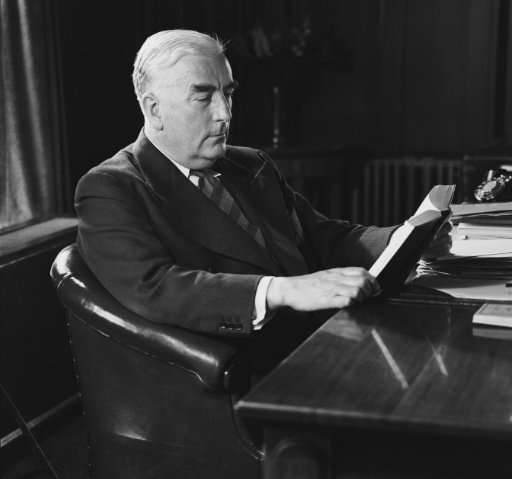On this day, 2 June 1953, Robert Menzies attends the Coronation of Queen Elizabeth II as the leading representative of Australia. As a Commonwealth Prime Minister Menzies would take part in the grand procession from Buckingham Palace to the Coronation site at Westminster Abbey – though he was slightly behind heads of state, such as the Sultan of Zanzibar, when it came to the pecking order of proceedings.
Coronation day was unseasonably wet and cold, but this did little to dampen the spirit of the occasion. Menzies and his wife Pattie were in the second coach procession along with the nine other Commonwealth Prime Ministers, and they had their own personal vehicle drawn by six horses co-opted from a local brewery. Menzies would later describe the experience as that of travelling in ‘a very draughty hearse…There was a bitter wintry breeze, and you could exclude it by closing the window, but if you closed the window you were not able to wave to your constituents’. Those ‘constituents’ included the Australian cricket team, whom Menzies was very familiar with and spotted in the crowd.
Guests and officials passed about three million spectators in London, some having camped out overnight to secure a good spot, others benefitting from specially built stands and scaffolding. During the procession the Queen wore the George IV State Diadem, which was made in 1820 and featured roses, shamrocks and thistles, with some 1,333 diamonds and 169 pearls.
Queen Elizabeth’s Coronation was the first ever to be televised by the BBC, securing more than 27 million viewers in Britain, with millions more around the world watching the coverage – though not in Australia, where the Menzies Government had been reluctant to introduce television because they felt it would divert important resources. Australians would thus have to wait for newsreel and movie versions displayed in the cinema, though they were not alone in missing out on seeing the actual Act of Consecration, as it was considered too sacred to be filmed. Menzies was an enthusiastic recorder of home movies, and while he was too preoccupied to shoot the Coronation himself, he got his secretary to take some footage which has been preserved by the National Film and Sound Archive.
The Coronation service conducted by the Archbishop of Canterbury took nearly three hours. The Queen was crowned in St Edward’s Chair, which was made in 1300 for Edward I and has been used for every Coronation ever since. The oil was poured from an Ampulla, a flask in the shape of an eagle wrought in solid gold, onto the Coronation Spoon, an artefact which was a lucky survivor of the English Civil War. Most of the original regalia had been sold off following Charles I’s execution in 1649, or melted down to fund the short-lived Republic, hence many of the other items used dated to Charles II and the Restoration.
After the ceremony Menzies gave a statement as part of a BBC broadcast entitled ‘Long Live the Queen’ which epitomised the esteem in which the monarchy was then held in Australia:
‘In my few words, all too few to speak what is in my heart, I would like to speak to the Queen for my own beautiful and youthful country, Australia. Your Majesty, we in Australia are all your most dutiful and loving subjects. Today some of us have with deep emotion seen you crowned: crowned not for tyranny but for service; not for power but for duty; not for pomp and circumstance but for friendly and understanding leadership of a great and brave and enduring people.
This is a memorable day. None who have lived through it in your sight and presence can ever forget it. For you, Your Majesty, it was a day of dedication and the spirit of dedication is not a stranger in your ancient and royal house. For us it was a day of joy, of proud memories, of soaring hopes for a glorious and serene future, it has above all been a day of solemn resolve that, come what may, we shall prove as worthy of you our Queen, young, clear and radiant as we know you will be of the solemn trust this day reposed in you by Church and State under the Benediction of the God of our fathers.’
Such sentiment was not just the enthusiastic endorsement of an incorrigible Anglophile, the vast crowds and near hysteria that would accompany the Royal Tour of Australia held the next year would prove that this positive opinion was widely held throughout the nation. Menzies, and most people in the country he led, had been brought up to admire Britain’s constitutional monarchy as one of the oldest and most successful systems of government in the world. From Magna Carta to the Glorious Revolution, key rights had been won from the Crown, and the monarchy had been transformed into a symbol of stability that was believed to safeguard rather than repress democracy. Democracy is after all a potentially fragile system, and the unity provided by a beloved, respected and permanent neutral figurehead helps to give it ballast to survive the storms of partisan fury.
Further Reading:
‘Empire P.M.’s Pay Tribute to Queen’, The Age, 3 June 1953, p.6. 03 Jun 1953 – EMPIRE P.M.’s PAY TRIBUTE TO QUEEN – Trove (nla.gov.au)
A.W. Martin, Robert Menzies, A Life Volume 2 1944-1978 (Melbourne University Press, 1999).
‘Menzies RG: Our Coronation Tour’, National Film and Sound Archive, Menzies RG: Our Coronation Tour (1953) clip 2 on ASO – Australia’s audio and visual heritage online
Sign up to our newsletter
Sign up for our monthly newsletter to hear the latest news and receive information about upcoming events.


